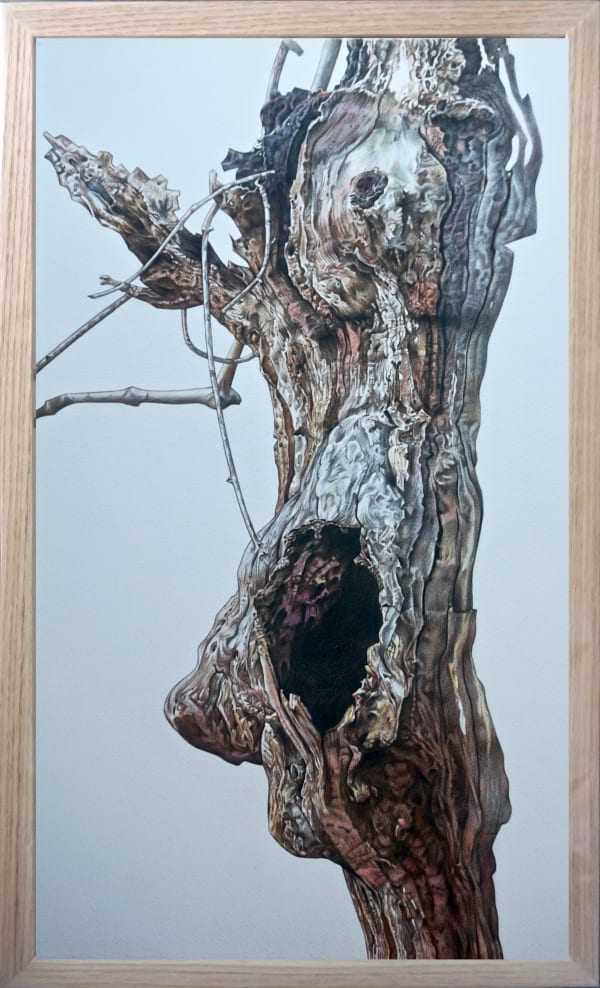Mike Dodd
The Thicks II, 2023
Coloured pencil on paper
Framed 59 x 36 x 5 cm
£ 1,100.00
Mike Dodd, The Thicks II, 2023
Sold
Mike Dodd, The Thicks II, 2023
Sold
Currency:
Ancient trees in Staverton Park, Suffolk A large area of the farm devoted to conservation is Staverton Park and The Thicks. This block of 240 acres of woodland is now...
Ancient trees in Staverton Park, Suffolk
A large area of the farm devoted to conservation is Staverton Park and The Thicks. This block of 240 acres of woodland is now a “Site of Special Scientific Interest”. The Park itself is thought to be the largest area of ancient pollarded oaks in Europe and, together with The Thicks, has some invertebrates, spiders, fungi and lichens found in only a few other locations in the UK.
Staverton Park also has a colourful history, the name of Staverton is thought to be of Saxon origin, either from the word "steorfar" meaning slaughter, or from ''place of staves". It is said that these "ancient oaks witnessed the fierce strife between Angles and Wends in the 10th Century, where tumuli were thrown over the fallen heroes". Maybe this is the "slaughter" which gave rise to the name of Staverton.
Staverton Park was more than likely created as a hunting ground by enclosing open woodland and rough pasture between earthen banks. In 1086, the Domesday Book refers to ''woodland for thirty swine for the Manor of Stavertuna". However, it has been supposed that the actual date of emparkment of the mature trees was 1178, because the Pipe Rolls of that year record a sharp increase in rent to the King from £14 to £20. This is most likely to have occurred when Staverton Manor was acquired by the Bigod family who were responsible for emparking up to fourteen other locations in the county. It was around this time that the inhabitants of the Park began to change, with the introduction of rabbits by the Normans, and the last wolf being sighted in the Park in 1150.
The Park was not only used to keep deer, it also produced a variety of other woodland resources and provided grazing for other forms of livestock. Especially during the 13th Century, the Park was a good source of acorns, wood and grazing but a considerable reduction in income in the early 14th Century showed a decline in demand following the Black Death in 1349 which, it has been suggested, wiped out Wantisden and Butley. In 1382 William de Ufford describes the Park as being ''without deer, now greatly broken down". Whether this was the result of neglect or the effects of the Peasants Revolt of 1381 is not indicated. However, the area did experience the effects of the revolt, with the house of John de Staverton, a JP, being looted and destroyed by a mob. It was not until the 1500's that the oaks were pollarded with the ''wattlesticks" being used for early house construction. These mature oaks were then pollarded at fifty year intervals and, hence, formed in to the present day shape of crown oaks when pollarding ceased. During this time the Park was owned by the Duke of Norfolk, however, in 1529 the Park was sold to the Priors at Butley Abbey, however, it was the year before this acquisition that the monks recorded an important visitor to the Park in the Butley Priory Chronicle. On the 11th September, 1528 Mary Tudor (Henry VIII's sister), Dowager Queen of France and Duchess of Suffolk, came to Staverton Park. She hunted foxes and had a picnic lunch with cheerful, laughing gentry "sub quercubus" under the oaks in "Parcum de Staverton". The fact that they hunted only foxes may indicate that the Park was without deer. After the suppression of Butley Abbey in 1540, the Park passed into lay hands and by the end of the century it was acquired by Sir Michael Stanhope who had a survey made by John Norden in 1601 which provides the earliest indication of the topography of the Park.
Share
- X
- Tumblr
Related artworks
-
 The Thicks III, 2023Mike DoddGouache and pastel pencil on paperFramed 70 x 46 x 5 cm£1,300.00Sold
The Thicks III, 2023Mike DoddGouache and pastel pencil on paperFramed 70 x 46 x 5 cm£1,300.00Sold
Mike Dodd, The Thicks III, 2023Sold1,300.00 -
 The Thicks I, 2023Mike DoddColoured pencil on paperFramed 59 x 36 x 5 cm£1,100.00Sold
The Thicks I, 2023Mike DoddColoured pencil on paperFramed 59 x 36 x 5 cm£1,100.00Sold
Mike Dodd, The Thicks I, 2023Sold1,100.00 -
 Kett's Oak - full set of 9 drawings, 2017Mike DoddCharcoal and pastelFramed 198 x 267 cm£14,000.00Sold
Kett's Oak - full set of 9 drawings, 2017Mike DoddCharcoal and pastelFramed 198 x 267 cm£14,000.00Sold
Mike Dodd, Kett's Oak - full set of 9 drawings, 2017Sold14,000.00 -
 Sweet Chestnut Broken Bough, 2021Mike DoddGouache on clayboardBox framed: 41.5 x 52 cm£1,100.00Sold
Sweet Chestnut Broken Bough, 2021Mike DoddGouache on clayboardBox framed: 41.5 x 52 cm£1,100.00Sold
Picture area: 30 x 40 cm
Mike Dodd, Sweet Chestnut Broken Bough, 2021Sold1,100.00 -
 Sweet Chestnut Bark, 2021Mike DoddGouache on clayboardBox framed: 52 x 41.5 cm£1,100.00Sold
Sweet Chestnut Bark, 2021Mike DoddGouache on clayboardBox framed: 52 x 41.5 cm£1,100.00Sold
Picture area: 40 x 30 cm
Mike Dodd, Sweet Chestnut Bark, 2021Sold1,100.00 -
 The Thicks II, 2023Mike DoddColoured pencil on paperFramed 59 x 36 x 5 cm£1,100.00Sold
The Thicks II, 2023Mike DoddColoured pencil on paperFramed 59 x 36 x 5 cm£1,100.00Sold
Mike Dodd, The Thicks II, 2023Sold1,100.00 -
 The Glastonbury Thorn, 2022Mike DoddCharcoal and pastelFramed 63.5 x 81 cm£1,380.00Sold
The Glastonbury Thorn, 2022Mike DoddCharcoal and pastelFramed 63.5 x 81 cm£1,380.00Sold
Mike Dodd, The Glastonbury Thorn, 2022Sold1,380.00 -
 The Thicks IV, 2023Mike DoddGouache and pastel pencil on paperFramed 73 x 57 x 5 cm£1,300.00Sold
The Thicks IV, 2023Mike DoddGouache and pastel pencil on paperFramed 73 x 57 x 5 cm£1,300.00Sold
Mike Dodd, The Thicks IV, 2023Sold1,300.00








